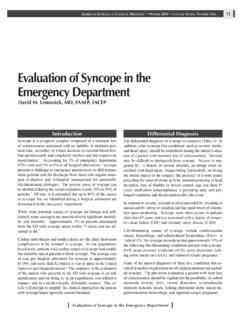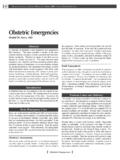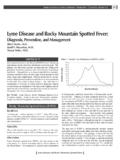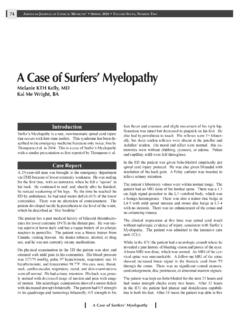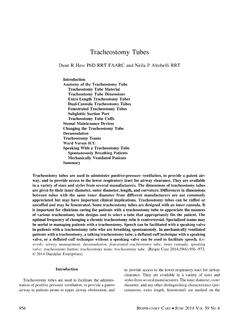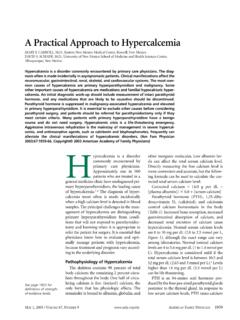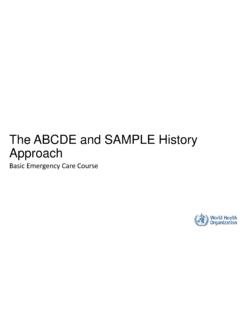Transcription of An Approach to the Initial Care of Patients with Chest ...
1 24 American Journal of Clinical Medicine Winter 2009 Volume Six, Number One An Approach to the Initial care of Patients with Chest pain in an Emergency Department Located in a Non-Cardiac Center Alex A. Agostini-Miranda, Loren A. Crown, Abstract to be considered. It is only after an appropriate medical history, a physical exam, and investigational steps are completed that Emergency department management of Chest pain is a com- the physician will be able to exclude some of these entities. Of- mon, with potentially serious problem.
2 with multiple risk fac- ten it takes multiple investigations over time to come to an ad- tors, target groups, and care pathways, the myriad etiologies equate definition of the etiology of the Chest pain . Nonetheless, of Chest pain can be perplexing. This article describes some of screening for these critical causes of death are paramount for the the diagnostic and risk stratification scenarios currently used in emergency physician managing Chest pain . Finally, remember, departments which do not have percutaneous cardiac interven- causes of Chest pain are not limited to the thorax.
3 Tion capabilities. Causes of Chest pain The Short List! Introduction Cardiovascular: Miscellaneous: ACS/CAD/Angina Anemia (including sickle cell). Patients who appear in the emergency department, urgent care Herpes zoster Anomalous left coronary centers, or offices who state that their chief complaint is Chest Thyroid/adrenal problems Aortic dissection pain deserve an appropriate medical evaluation. In the US, Toxins Aortic stenosis there are approximately six to seven million visits per year to Arrhythmias Musculoskeletal: the emergency department or Chest pain units due to a chief Cardiac tamponade Arthritis complaint of Chest pain , of which million are admitted with Cardiomyopathy Costochondritis a diagnosis of acute coronary syndrome (ACS).
4 Of these, 25 Hypertrophic cardiomyopathy Fibromyalgic percent (400,000) meet criteria for acute myocardial infarction Kawasaki disease Muscular strain (AMI) by EKG criteria of ST elevation (STEMI), whereas 75 Mitral valve prolapse Myofasciitis percent meet criteria for the diagnosis of unstable angina (UA) Trauma Pericarditis/ myocarditis or non-ST elevation MI (NSTEMI).1-3 This means that the ma- Valvular heart disease Psychological: jority of Chest pain complaints are not due to ACS. Non-cardiac Somataform disorder Chest pain (NCCP) is the second most common reason for pre- Drug abuse: Anxiety/panic attacks sentation to the ED and accounts for approximately two to five Amphetamine Depression percent of all Cocaine Diet pills Respiratory/pulmonary: Party Drugs (LSD and Ecstacy) Asthma/reactive airway disease Though it is obvious that only a minority of these Patients have Cancer a coronary artery problem, the tragedy of a missed diagnosis and Foreign Body Gastric.
5 The resulting medico-legal problem, requires that we should rou- Hypoxia Diverticular disease tinely view Chest pain initially as an acute coronary syndrome Pleurisy Esophageal spasm Pneumomediastinum until proven otherwise. Four other critical causes of acute mor- Esophagitis Pneumonia bidity or mortality follow closely in the differential; they are: Gastritis Pneumothorax pulmonary embolism, aortic dissection, pneumothorax, and Gastroesophageal reflux Pulmonary embolism Multiple other etiologies are possible and may need disease Tracheitis An Approach to the Initial care of Patients with Chest pain American Journal of Clinical Medicine Winter 2009 Volume Six, Number One 25.
6 Chest pain in Children Chest pain in Adults Widespread public information messages have made people Heart disease remains the leading cause of death in the United more aware of heart disease in children, so it is not surprising to States with an estimated direct and indirect cost of approximate- find many anxious parents camped out in the ED with a healthy, ly $ billion for 2006,4,10-11 but certainly not all people who non-toxic child who has a complaint of Chest pain . Some of this arrive in the ED or clinic with the complaint of Chest pain are anxiety is based on media cases involving sudden cardiac death experiencing heart disease.
7 Certainly, as Patients become older, in young children. It should be remembered that in the majority more obese, and less active, the risk of developing coronary of cases sudden death in children does not include complaints artery disease and dying from it increases. It is also important of Chest pain . The etiology of sudden death in children has been to remember that it is not only ACS (whether STEMI/NSTEMI). postulated to be due to structural defects or to arrhythmias that that kills Patients , but other etiologies such as pulmonary em- could have its origin in genetic abnormalities of the ion chan- bolisms, dissecting aortas, pneumothorax, and pneumonias that nels that affect the channel structure and Of all cases may also kill Patients .
8 Of Chest pain reported in children only 5% are attributable to a cardiac Pulmonary embolism is a legendary challenge for emergency physicians. The classic description of sudden onset of pleuritic As you begin the evaluation of a child with Chest pain consider Chest pain associated with shortness of breath, abnormal vital that in most cases there will be a child attached to two parents. signs, and hypoxia is not the most common presentation. Well's When you remember that the worst nightmare for any parent is criteria is the most widely used method for evaluating Patients the loss of a child, make certain to pay heed to the fact that you by stratifying them into risk categories.
9 Low-risk Patients cur- may have three Patients and not just one. rently are being excluded by use of the d-dimer. All others require investigations by ultrasonography and/or CT angiog- Start your evaluation by inspecting the vital signs (they are called vital for a reason and the emergency physician will be held re- raphy; various strategies exist for thrombolysis. Patients with sponsible for any abnormal vital sign that remains unexplained) aortic dissection are described as presenting with severe tear- making sure to document the four cardinal ones, plus the O2 satu- ing or sharp Chest pain that is sudden in onset.
10 However, this ration, as you observe the child. An active, playful child may classical description is unfortunately not always seen. Many be the best sign of reassurance that you, the doctor, can obtain, Patients present with neurological symptoms or syncope as the but it is rarely sufficient for the parent. Therefore, you must ob- Initial complaint. Hypertension in the elderly remains the main tain the complete history of pain documenting the quality, inten- risk group, but those with historical findings such as connective sity, location, temporal relationship to events, provocative and tissue disorders and sudden death in family members are also palliative factors, and associated symptoms.

